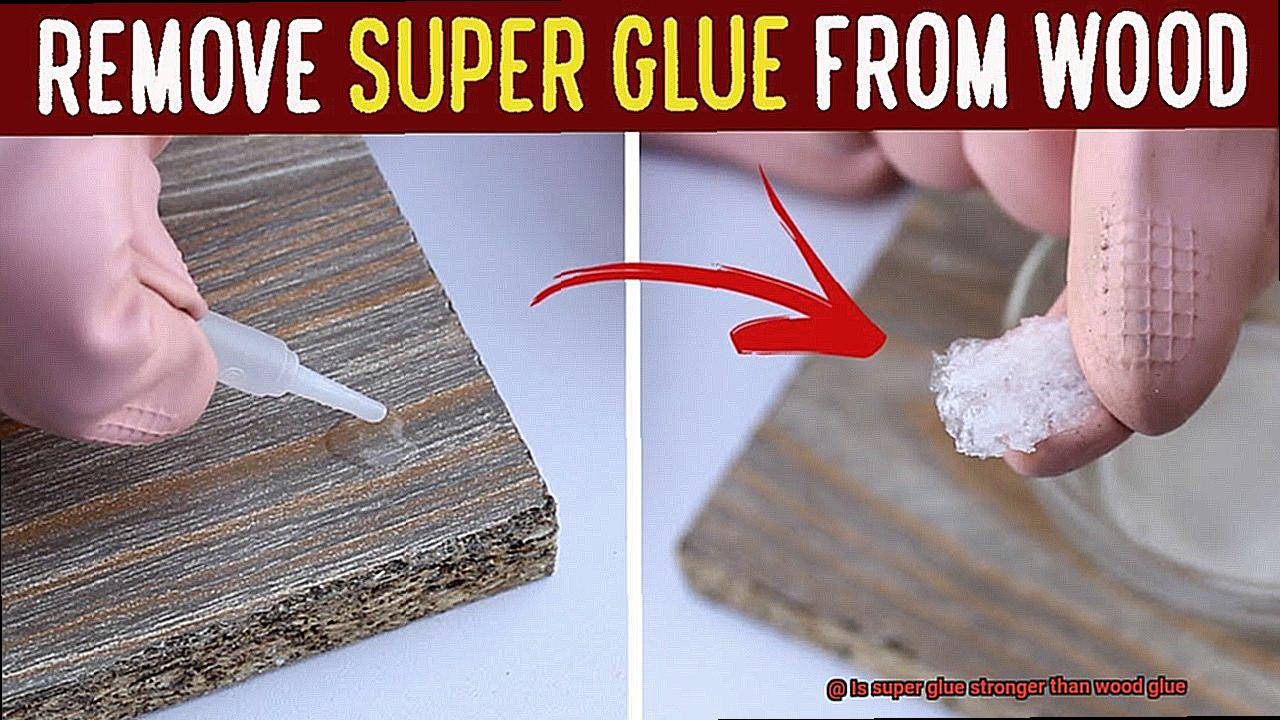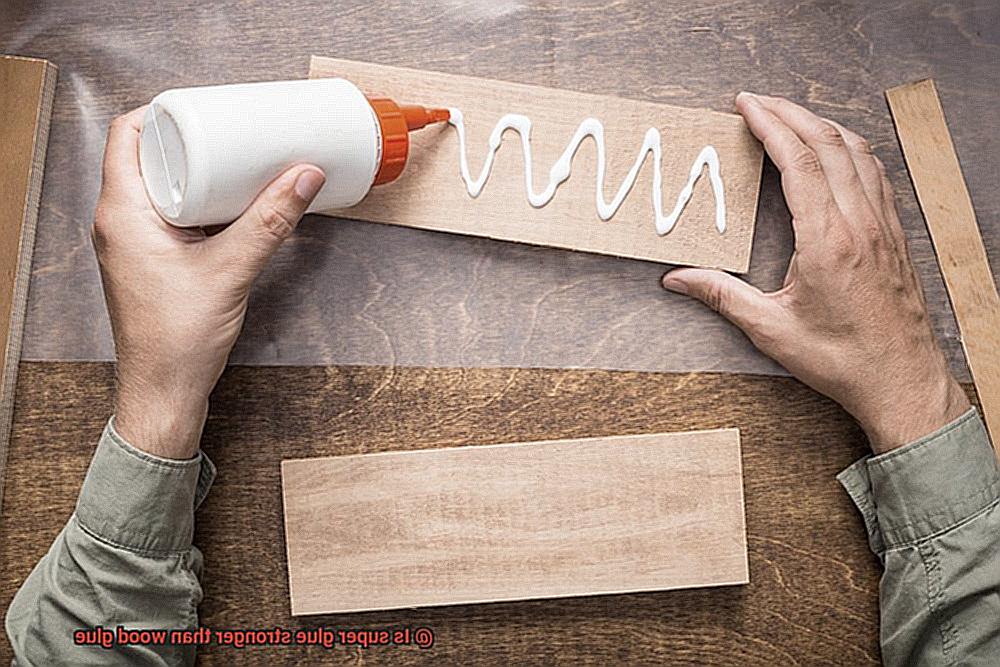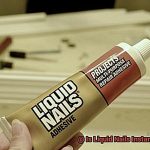Title: Super Glue vs. Wood Glue: The Ultimate Battle of Bonding Power.
Hey there, fellow DIY enthusiasts and glue aficionados. Have you ever found yourself in a sticky situation (pun intended) where you just can’t decide between super glue and wood glue? Well, fear not, because today we’re diving headfirst into the great glue debate to settle once and for all which adhesive reigns supreme.
Picture this: you’ve spent hours meticulously crafting that one-of-a-kind wooden masterpiece, only to have it break right before your eyes. It’s heart-wrenching, isn’t it? But fret no more, my friends. We’re about to embark on an epic journey to discover which glue is the true hero in this tale of bonding triumph.
So grab your safety goggles and prepare for a wild ride as we explore the secrets, strengths, and weaknesses of super glue and wood glue. We’ll uncover their hidden powers and reveal the ultimate winner in this showdown of adhesion excellence. By the end of this post, you’ll be armed with the knowledge to conquer any bonding challenge that comes your way.
Let’s get ready to witness a battle like no other – Super Glue vs. Wood Glue – who will emerge victorious? Stay tuned as we unravel the mysteries behind these adhesive giants and determine once and for all which glue has what it takes to withstand the test of time. Get ready for some serious bonding action.
What is Super Glue?
Contents
Super glue, also known as cyanoacrylate adhesive, is a remarkable adhesive that bonds quickly and strongly. It comes in small bottles or tubes and appears as a clear liquid. Despite its unassuming appearance, super glue is incredibly powerful.
The key ingredient in super glue is a chemical compound called cyanoacrylate. When this compound comes into contact with moisture, it undergoes a rapid polymerization reaction, forming strong bonds. This unique property allows super glue to work its magic within seconds of application.
One of the most impressive features of super glue is its speed. Unlike other adhesives that take hours to dry, super glue bonds instantaneously. It’s like having a magical fix at your fingertips. This makes it perfect for those urgent repair jobs where waiting around for glue to dry is simply not an option.
But fast-acting isn’t the only thing that makes super glue so special. Once it cures, it forms an incredibly strong and durable bond that can withstand significant stress. Whether you’re sticking together plastic, metal, glass, rubber, ceramics, or even some types of wood, super glue has got you covered.
In addition to its strength, super glue is also highly resistant to temperature changes, moisture, and chemicals. It can handle tough conditions without losing its bonding power. However, it’s important to note that prolonged exposure to excessive heat or water can affect its effectiveness.
While super glue is a versatile adhesive, it’s important to know its limitations. It may not work as well on porous surfaces like fabric or foam because they don’t provide a smooth enough surface for the glue to bond properly. Additionally, certain plastics like polyethylene or polypropylene are resistant to super glue and may require a different type of adhesive.
Using super glue is relatively simple. Just ensure that the surface you’re bonding is clean and dry before applying the adhesive. A little goes a long way with super glue, so you only need a small amount to achieve a strong bond. However, be cautious when handling it because super glue can bond skin and other surfaces together in an instant. If this happens, don’t panic. Soak the affected area in warm, soapy water to release the bond.
What is Wood Glue?
Wood glue, also known as carpenter’s glue or yellow glue, is an essential tool in every woodworker’s arsenal. This versatile adhesive offers a strong and durable bond that can withstand the test of time. Whether you’re a professional craftsman or a DIY enthusiast, understanding the ins and outs of wood glue is crucial for your woodworking projects. So, let’s dive into the world of wood glue and discover why it’s the carpenter’s secret weapon.
The Power of Porosity:
Wood glue is specifically designed to bond porous surfaces effectively. Unlike other adhesives, wood glue has the ability to penetrate deep into the wood fibers, creating a strong and reliable bond. This makes it perfect for woodworking projects where irregularities and absorbent properties of wood are common.
Liquid vs. Gel:
Wood glue comes in two main forms: liquid and gel. Liquid wood glue has a thinner consistency, making it easier to spread and work into those hard-to-reach areas. On the other hand, gel wood glue has a thicker texture, providing excellent gap-filling capabilities and making it ideal for vertical applications.
Patience is Key:
While wood glue sets within 30 minutes to an hour, it’s important to allow sufficient drying time for complete curing. Depending on factors like temperature and humidity levels, this process can take up to 24 hours or longer. Patience is crucial to ensure a strong and durable bond that will last for years to come.
Strength and Durability:

Wood glue offers a superior bond that can withstand the stresses and strains commonly encountered in woodworking projects. It provides excellent heat resistance, making it suitable for applications where bonded materials may be exposed to high temperatures.
Safety First:
One of the greatest advantages of wood glue is its non-toxic nature. It is safe to use, making it suitable for both professional craftsmen and DIY enthusiasts. Additionally, wood glue dries clear, resulting in seamless joints that enhance the overall appearance of your finished project.

Customization Made Easy:
Wood glue allows for further customization and finishing touches. Once dry, it can be easily sanded and painted over, giving you the freedom to add your personal touch to your woodworking masterpiece.
Strength Considerations for Different Applications
When it comes to choosing the right glue for your project, strength is a crucial factor to consider. Super glue and wood glue are two popular options, each with their own unique strengths and weaknesses.
Super glue, also known as cyanoacrylate adhesive, is well-known for its incredible bond strength. It forms an instant bond when it comes into contact with moisture, making it ideal for quick repairs or bonding materials like plastic or metal. The bond created by super glue is highly resistant to pulling forces, making it suitable for applications that require high tensile strength. Additionally, super glue is also highly resistant to moisture and temperature changes, making it suitable for both indoor and outdoor use.
On the other hand, wood glue, also known as carpenter’s glue or PVA glue, is specifically designed for woodworking projects. It provides a strong bond tailored for joining pieces of wood together. Wood glue has a longer open time, meaning it takes longer to dry. This allows for better positioning and adjustment of the pieces being glued, which is particularly advantageous when working on larger woodworking projects that require precision and alignment.
In terms of sheer strength, super glue generally outperforms wood glue. Its bond is incredibly strong and resistant to pulling forces. This makes it suitable for applications where high tensile strength is needed, such as bonding metal or plastic parts.
However, it’s important to note that while super glue excels in tensile strength, it may not be the best choice for applications that involve shear stress. Shear stress occurs when two surfaces slide against each other in opposite directions. In such cases, wood glue may be a more suitable option as it provides a stronger bond under shear stress. This is particularly relevant in woodworking projects where the joint may be subjected to lateral forces or movement.
When choosing between super glue and wood glue, it’s also important to consider the type of materials being bonded. Super glue works well on a wide range of materials including plastic, metal, ceramic, and even some types of fabric.
Wood glue, on the other hand, is primarily used for bonding wood surfaces. Its formulation allows it to penetrate the wood fibers, creating a strong bond that is resistant to stress and strain.
Advantages of Super Glue
When it comes to finding a reliable adhesive, look no further than super glue. This incredible adhesive has earned a well-deserved reputation for its instant bonding, remarkable strength, and unmatched versatility. Whether you’re a DIY enthusiast or a professional craftsman, super glue is the adhesive of choice. In this article, we’ll take a deep dive into the advantages of using super glue and discover why it’s the go-to adhesive for countless projects.
Instant Bonding:
Super glue’s standout feature is its ability to bond surfaces together in an instant. No more waiting around for hours for the adhesive to dry – with super glue, you can get things done in a flash. This quality makes it ideal for quick fixes and repairs, saving you valuable time and effort.
Versatility:
Super glue is the chameleon of the adhesive world – it can bond various materials with ease. From metal to plastic, rubber to ceramic, even leather – super glue excels at creating a strong bond on a wide range of surfaces. This unparalleled versatility makes it the adhesive of choice for countless applications, from household repairs to intricate crafting projects.
Strength:
When it comes to strength, super glue packs a powerful punch. Once it sets, it forms an incredibly strong bond that can withstand substantial stress and strain. This makes it perfect for bonding objects that may experience frequent movement or heavy loads. Additionally, its resistance to moisture and temperature variations enhances its durability.
Precision Application:
Super glue often comes with a precision applicator, allowing for accurate and controlled application. No more worrying about excessive glue spreading or creating a mess – with the precision applicator, you can target specific areas with ease. This feature is especially useful when working on intricate or delicate projects where precision is crucial.
Clear Finish:
Say goodbye to unsightly residue or visible marks left behind by other adhesives. Super glue dries clear, leaving behind an almost invisible bond line. This transparent finish is perfect for gluing objects with visible joints or when aesthetics are important. With super glue, you can achieve a seamless and discreet bonding solution.
Shelf Life:

Super glue has an impressive shelf life compared to many other adhesives. When properly stored in a cool and dry place, unopened super glue can remain usable for several years. This prolonged shelf life ensures that you always have a reliable adhesive on hand, ready for whenever a bonding need arises.
Accessibility:
Finding super glue is as easy as pie. It’s widely available in hardware stores, supermarkets, and online marketplaces. Its affordability and widespread availability make it a convenient option for individuals seeking a reliable adhesive without having to search extensively or spend a fortune.
Advantages of Wood Glue
For woodworking enthusiasts, having a reliable adhesive is crucial for creating sturdy and long-lasting projects. Enter wood glue, the superhero adhesive that offers numerous advantages for your woodworking endeavors. Let’s dive deeper into why wood glue is a must-have in your workshop.
- Strong Bond: The primary advantage of wood glue is its exceptional ability to create a strong bond between wooden surfaces. Whether you’re working with hardwoods, softwoods, plywood, or particleboard, wood glue penetrates deep into the wood fibers, forming a tight and secure connection. This means that your glued pieces will remain firmly attached, even under stress or pressure.
- Versatility: Wood glue is incredibly versatile and can be used for various woodworking projects. It can bond different types of wood together, such as oak, pine, or walnut. Additionally, wood glue can also bond wood to other materials like metal or plastic. This versatility makes it an excellent adhesive option for a wide range of applications.
- Ease of Use: Applying wood glue is a breeze. It usually comes in liquid form, allowing for easy spreading onto the surfaces that need to be bonded. You can use a brush or applicator to ensure even coverage. Plus, wood glue has a longer open time, giving you ample opportunity to adjust and position the pieces before the adhesive fully sets.
- Non-Toxic: Most wood glues are non-toxic and safe to use. You don’t have to worry about harmful fumes or strong odors while working on your projects. This makes wood glue ideal for indoor projects or applications where ventilation may be limited. It’s a great choice for those who prioritize their health and the environment.
- Sandable and Paintable: Wood glue dries clear and can be easily sanded down, creating a smooth surface that seamlessly integrates with the surrounding wood. This means that the glued area becomes virtually invisible, resulting in a more aesthetically pleasing finish. What’s more, wood glue is compatible with various finishes and paints, allowing for further customization and artistic enhancements.
- Long-Lasting Results: When used correctly and in appropriate conditions, wood glue provides long-lasting results. It forms a durable bond that can withstand temperature changes, moisture exposure, and other environmental factors without compromising its strength. This ensures that your woodworking projects will stand the test of time.
Remember, different types of wood glue may have specific advantages and limitations. It’s essential to choose the right wood glue for your project based on factors such as the type of wood you’re using, the level of moisture resistance needed, and the desired setting time. Consulting with a professional or referring to the manufacturer’s guidelines can help you achieve optimal results.
Types of Wood Glues
Woodworking is akin to conjuring magic with your hands. Whether you’re crafting a stunning piece of furniture or assembling intricate models, the key to success lies in a strong and reliable bond. Enter wood glues – the wizards of woodworking. However, not all wood glues are created equal. In this comprehensive overview, we’ll explore the different types of wood glues, each possessing its own unique characteristics and strengths. Join us on this enchanting journey as we unveil the secrets of these magical potions and help you choose the perfect bond for your next project.
PVA Glue: The Versatile Hero
Imagine having a glue that can do it all – that’s PVA glue for you. With its strong bond and ease of use, PVA glue is a top choice for many woodworkers. This water-based adhesive is a jack-of-all-trades, suitable for various woodworking projects. Whether you’re building a birdhouse or fixing a broken chair, PVA glue has got your back. Its ability to dry clear ensures flawless results, while its water-soluble nature allows for easy clean-up. Just remember, PVA glue works best on porous surfaces like wood, so choose accordingly.
Polyurethane Glue: The Mighty Gorilla
When it comes to strength and versatility, polyurethane glue is the superhero of wood adhesives. Known as Gorilla Glue, this powerful adhesive creates bonds so robust they can hold together even the toughest materials. Whether you’re working indoors or outdoors, polyurethane glue has got you covered with its waterproof properties. However, it requires moisture to work its magic, so dampening the wood surfaces before application is crucial.
Epoxy Glue: The Master of Durability
If durability is your priority, then epoxy glue is your go-to potion. This two-part adhesive creates a rock-solid bond capable of withstanding temperature changes, chemicals, and moisture. Picture a shield of protection for your projects. Epoxy glue sets slowly, allowing ample time for precise positioning before it cures completely. Its versatility extends beyond wood, making it suitable for various materials like metal and plastic.
Cyanoacrylate Glue: The Speedy Fixer
When time is of the essence, cyanoacrylate glue, or super glue, becomes your trusty sidekick. This fast-acting adhesive forms an instant bond between surfaces, making it perfect for quick repairs or delicate woodworking projects. Just a drop of this remarkable glue can work wonders. However, keep in mind that super glue may not be the best choice for large-scale woodworking projects as it can be brittle under stress.
When to Use Super Glue and When to Use Wood Glue
When it comes to adhesive options, choosing the right glue for your project can be a daunting task. Among the many choices available, two popular options are super glue and wood glue. Super glue, also known as cyanoacrylate adhesive, is perfect for quick repairs and bonding non-porous materials like metal, plastic, rubber, and ceramics. Its strength lies in its ability to create an instant bond that can withstand a significant amount of force. So, if you have a broken ceramic figurine or need to fix a plastic toy, super glue is the way to go.
On the other hand, wood glue is specifically designed for bonding wood surfaces. It creates a strong bond by penetrating the wood fibers and forming a tight joint. Available in different strengths and drying times, wood glue is versatile enough to suit various woodworking projects. Whether you’re building furniture or repairing a wooden frame, wood glue is the ideal choice.
But how do you decide which glue to use? Here are some factors to consider:
- Strength: Super glue provides an immediate and strong bond, perfect for small repairs. However, when it comes to long-term strength and durability, wood glue outperforms super glue. It creates a molecular-level bond with the wood fibers, ensuring a joint that can withstand stress and movement over time.
- Flexibility: Wood expands and contracts with changes in temperature and humidity. Super glue tends to be more brittle and may not handle these movements well. Wood glue, on the other hand, is more flexible and allows for the natural movement of wood without compromising the bond.
- Surface area: Super glue works best on small surface areas due to its fast-drying nature. It excels at bonding tight joints or repairing small cracks. Wood glue, on the other hand, is better suited for larger surface areas or joining multiple pieces of wood together.
- Reversibility: If you anticipate the need for disassembly or repair in the future, wood glue is easier to reverse compared to super glue. Wood glue joints can be loosened with heat or moisture, allowing for repairs or modifications. Super glue bonds, on the other hand, are typically permanent and difficult to separate.
xUCB4dhvVlc” >
Also Read: How Much Weight Can Hot Glue Hold?
Conclusion
In conclusion, when it comes to the battle of strength between super glue and wood glue, it is clear that super glue takes the crown.
With its ability to adhere to various materials, including wood, metal, plastic, and more, super glue proves its versatility and reliability time and time again.






